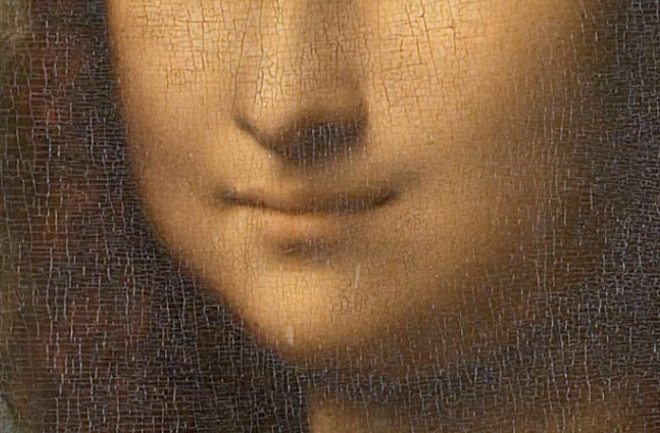Mona Lisa, the masterpiece and the most viewed painting in the world by the master artist Leonardo de Vinci has always been an inspiration for the world of Art. And for centuries, experts have attempted to unravel some of the surrounding mysteries of the Mona Lisa. Do you know about those mysteries? Let’s dig deep!
The most talked about mystery is hardly the most important. But you can’t avoid it. Why is Mona Lisa smiling?
According to the American author Dan Brown, who made the world’s most famous painting even more famous in his bestselling novel “The Da Vinci Code“, she smiles her small, ironic smile because she actually represents the fusion of the male and female elements of the universe. The proof: The Mona Lisa was supposed to be an anagram of the Egyptian god Amon and l’Isa, Italian for the Egyptian goddess Isis.
This explanation is of course freely invented like so much else in Dan Brown’s suspense novel. Although her identity has never been 100 per cent established, everything suggests that Mona Lisa is diminutive of Madonna (Monna) Lisa Gherardini, whose husband, Francesco del Giocondo, commissioned a painting of his beautiful wife.
An Opportunity for Detailed Analysis
From time to time, Mona Lisa’s smile disappeared for some brief remarks from the Louvre Museum in Paris, where she is otherwise visited every day by hundreds of admirers from all over the world. Because of the renovation work of the hall, Mona Lisa had to be in exile in the Louvre’s Rosa room for four years between 2001 and 2005. After the renovation was completed, the lady was brought home to a newly renovated Salle des Etats to accompany other Renaissance Venetian painters.
Now she is placed directly opposite the Louvre’s largest painting, Veronese’s Wedding at Cana, and painters such as Titian and Tintoretto are also in the fine, Italian Renaissance bloc of the Louvre.
And since the Mona Lisa had to be moved anyway, the Louvre’s restoration experts took the opportunity to look after her in every detail. In search of explanations for some of the art historical mysteries of the Mona Lisa, which, unlike Dan Brown’s, have real hold in reality.

The Mysteries of Mona Lisa Revealed
Among the new findings, experts found some landscape facts about the painting which bring us the historical facts and mysteries of the Mona Lisa.
For example, how did Leonardo manage to produce the so-called sfumato effect, which blurs the contours and makes the Mona Lisa pop out of a hazy landscape?
According to Louvre conservator Anne Scaillerez, Leonardo probably painted several consecutive layers with a very thinly dissolved, volatile paint. But experts cannot say with certainty.
Mona Lisa’s hazy yet unusually detailed representation has fascinated art lovers and ordinary people for nearly 500 years.
Even da Vinci’s contemporaries were taken aback by the painting because it was so unusual and technically far better than all other paintings that had been seen so far. And since then, everyone tried to imitate da Vinci’s techniques.
Attempt to Paint Beauty Beyond Gender
Among the unknown mysteries of the Mona Lisa, the portrayal of beauty is of great importance.
When Leonardo da Vinci painted the Mona Lisa, he was looking for a technique that would make it possible to paint “Beauty”. Not specifically female beauty, but beauty as an aesthetic principle. He wanted to capture the ideal of beauty with his brush.
Though he never finished it but returned and painted on it again and again. According to the expert, he never parted with it, even though it was a commissioned work that should have been given to Mona Lisa’s husband.
Giorgio Vasari, an expert on Leonardo published a work in 1550 named “The Lives of the Best Painters, Sculptors and Architects”, where he said da Vinci worked on the Mona Lisa in Florence from 1503 until 1506 when he left the city. However, it was probably not finished then. Specialists reckon that he continued to paint Mona Lisa, perhaps as late as 1513-1514, during his stay in Rome.
Extremely Fragile
Apart from experts, X-rays have also found that the great artist painted directly on the wood without any sketch. And it is a sign that it is a mature and experienced master who wields the brush. And he did so with extraordinary finesse. The paint is so thinly and delicately applied that you can sense the wood fibres underneath.
But despite the many high-tech studies, experts did not get all the answers that they have been asking themselves for years.
Thus, Anne Scaillérez describes, “We have not found out which varnish and which binders he used. In return, we have received a lot of valuable information about the wooden panel on which the Mona Lisa is painted. The painting is extremely fragile, and in order to protect and preserve the painting, we must know the substrate down to the smallest detail,”.
The 77 cm high and 55 cm wide poplar panel on which da Vinci painted the Mona Lisa has given way so that the panel is no longer completely flat, and this bending occurred very early, already when da Vinci was painting his mysterious model.
The high-tech investigations have revealed that the artist had to compensate for a height difference of up to eight millimetres by priming with a whitish mass.
But the wooden panel continues to make the painting so fragile that the slightest fluctuation in temperature and humidity may damage the Mona Lisa. Experts worry that it can increase the cracks and enlarge the 11cm long.
In her new display, she is therefore kept at a constant temperature of 20 degrees and a humidity of 50 percent. Nothing surprising for one of the most expensive paintings in the world, right? (Because, it has never been auctioned like others).
Was Not Popular Until It was Stolen
Today, Mona Lisa is the most important artwork in the world, but she did not have this wild attention before 1911. Though the search for the mysteries of the Mona Lisa among Leonardo da Vinci’s contemporaries were very deep, for many years she lived a very discreet life at the Louvre Museum, where no visitor took a particular interest in the old lady. Until she was stolen. On August 22, 1911, it is discovered that La Joconde, as she is called in France, is gone.
The French press resounds with lamentations over the loss of this national treasure. Two years later, an antique dealer in Florence is offered the artwork by an Italian nationalist, who explains to the police that he wanted to bring the painting home to Italy because he mistakenly believed that the painting had been stolen by Napoleon during his Italian campaigns.
In fact, everything suggests that da Vinci sold the Painting to the French King Francis the First in his last year.
The theft made the Mona Lisa famous. When she visited New York in 1963, Jackie and John F. Kennedy allowed themselves to be photographed with her. Later on, the loan to Moscow and Tokyo, made her admirers queued for hours for a few seconds of glimpses of her.
Mona Lisa is a medically created celebrity, says Anne Scaillérez. She also said, “Of course, we are happy that she is so popular and that so many people come to the Louvre to see her. But the Mona Lisa is a misunderstood work of art. Many are disappointed when they see her because the painting shows so little in its display case. In fact, it requires quite a lot of art historical insight to be able to appreciate the Mona Lisa.

The Mystery Behind the Smiling Mona Lisa
Dan Brown’s De Vinci Code has made it popular and the description might have some reality in it. Because the mysteries of the Mona Lisa continue to surround her smile.
For example, did Leonardo da Vinci paint two pictures of Lisa Gherardini, as an Italian art critic claimed? And to whom does the fingerprint that the high-tech investigations have revealed at the edge of the picture belong?
No one can let their emotions get away from Mona Lisa. There are dozens of fake Mona Lisas. However, her smile is something that will remain mysterious forever. And the fingerprint will get this dry remark along the way.
Anne Scaillérez says, “It may be ourselves who have set it. And if it was Leonardo’s, then there is nothing revolutionary in it. After all, it is not unusual for painters to touch their works.
Mona Lisa is subtle and mysterious enough in itself. She doesn’t need the imaginative concoctions of Dan Brown or anyone else to fascinate us.
